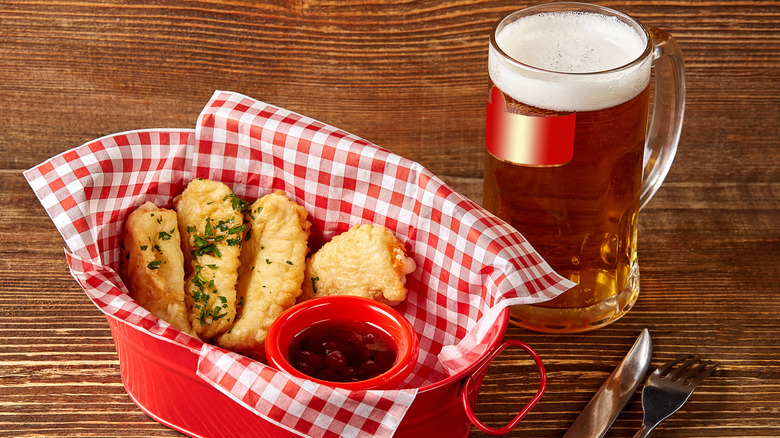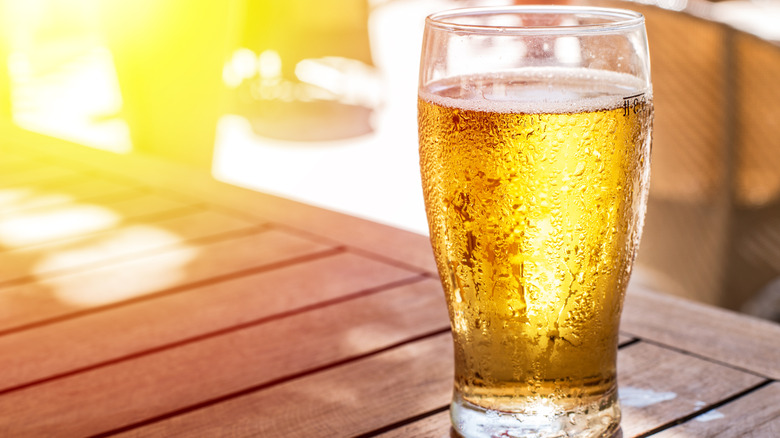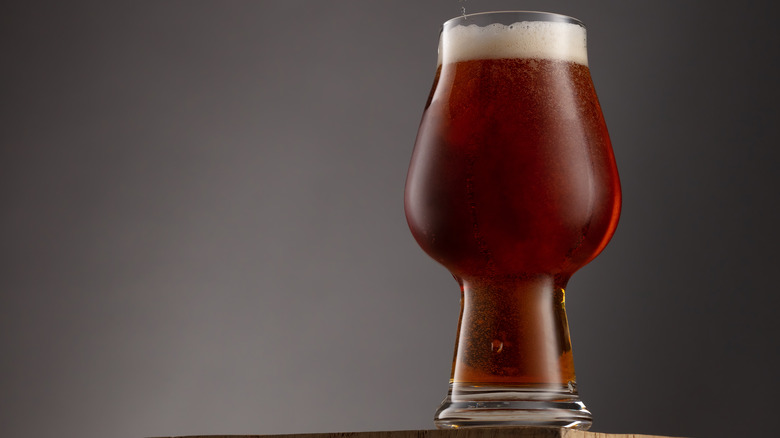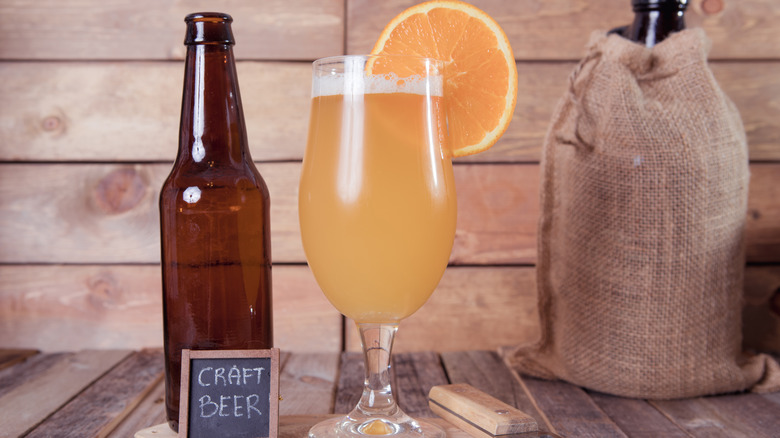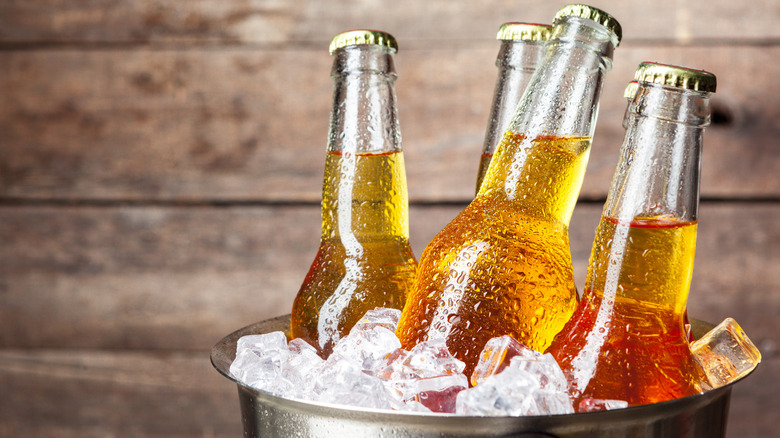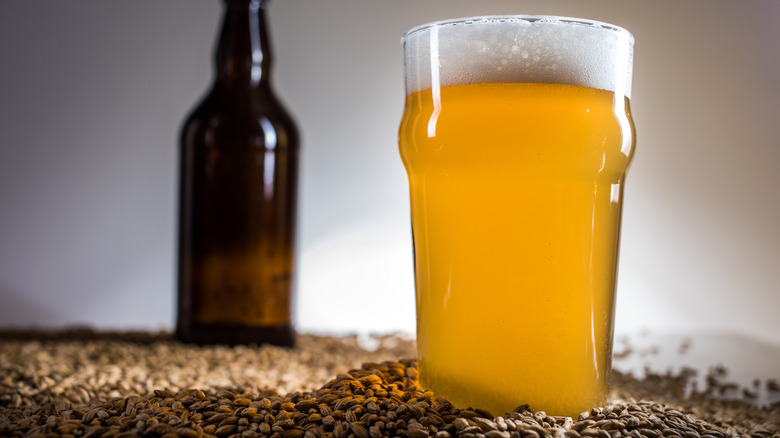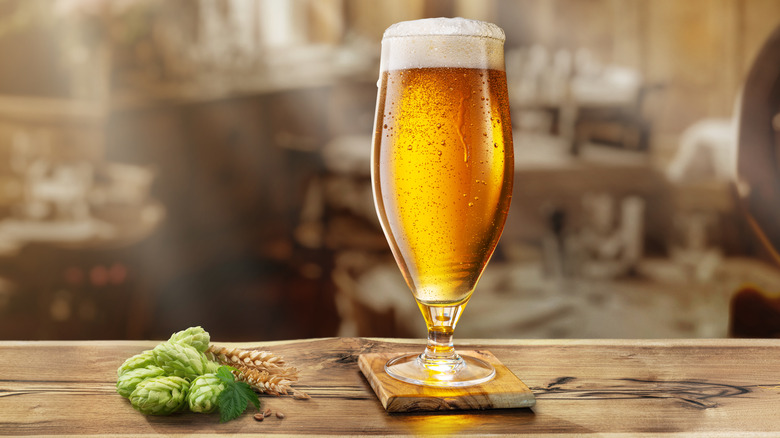The Best Types Of Beer To Add To Your Batter
Even if you're not a regular beer drinker, perhaps you've enjoyed the crisp pleasures of beer-battered fried food. From chicken fingers to onion rings, beer batter is an extremely versatile and crunchy covering for many types of deep-fried dishes. What makes this batter so successful is due to its boozy chemistry. Because alcohol evaporates faster than other liquids, it helps the fried food cook faster. Plus, the carbon dioxide bubbles trapped in the batter burst in the high-temperature oil, creating an extra-crispy exterior during the frying process. This is to say nothing of the lovely, hoppy flavor that the beer imparts to the batter as well.
The good news is whipping up an easy beer batter is completely fuss-free. The only hard part is selecting the right pint for the job — and, really, it's only difficult because there are so many to choose from. Below is the ultimate list of draughts, from rich roasted Irish stouts to bright citrus-infused Belgian wheat ales, perfect for adding a welcome splash of flavor and carbonation to your batter. Keep in mind, though, whatever you choose, it should be a beer you like to drink. If you like the taste of it in a glass, chances are you'll like it cooked this way as well.
The most versatile: Pilsner
The king of pale lagers, a pilsner is one of the more popular beers on the market. This is due to its goldilocks-like quality, boasting a flavor that's not too hoppy, not too malty, but just right in its taste profile. Lightly golden and highly carbonated, there are several pilsner styles available, from American to German. Most are fair game for beer batter (Pilsner Urquell, Stella Artois, Modelo, and Firestone Pivo Pils are particularly nice), with the exception of Bohemian pilsner, which comes with a heavy dose of spices that can change the overall flavor of your dish.
In a beer batter, pilsner is one of the more low-key options. Because it offers such an inoffensive flavor profile, a pilsner works in almost any pairing, from beer-battered chicken to fish. It's also a great complement to spicier fried foods like jalapeño poppers. For your first time making beer batter, it may behoove you to start with a pilsner to set your baseline, then you can begin trying more adventurous flavor combinations.
The boldest flavor: Dry Irish stout
One of the darkest beers on the list, Irish stouts (think of classic creamy Guinness and Murphy's) offer quite a robust flavor profile. Much of the characteristics are defined by the intense roasted barley and malt notes. In fact, its borderline dessert-like qualities make it a natural liquid addition to chocolate cake or chocolate pudding.
As for adding it to beer batter, a stout's darker hue will affect the color, creating a more browned exterior in the final result. The nitrogen often used to add silky carbonation to the stout also aids in heightening the crispy texture of the batter when fried. More than anything, though, Irish stout will supercharge the overall flavor of the batter, packing more of a punch than some of the lighter options on this list.
Its nutty, bitter notes make it a good complement to mildly sweet seafood and onion rings, so consider using it in beer batter for those items. If you're looking for something heavy on the malty aromas, Irish stout is your best bet.
The citrusy option: Belgian-style wheat beer
Belgian-style wheat beers (aka witbiers) are often defined by two signature flavors: orange peel and coriander. Lacking hoppy bite but offering plenty of citrus notes, witbiers are golden in color and highly carbonated. Other spices and herbs can be added to the brewing process, like cumin, lavender, and chamomile, but coriander is the most common. Allagash White and Blue Moon are classic options at the bar and good choices to add to your beer batter as well.
Like other golden beers, the witbier won't affect the color of your beer batter. Instead, most of its input comes in the form of a bright citrus taste. This almost floral hint of orange and coriander makes it a lovely companion to deep-fried desserts, like iconic fried Oreos or even plain fried poundcake balls. It'll also punch up the flavor for Asian-style fried chicken and shrimp if you'd like to take your beer batter in a more savory direction.
The most bread-like: Brown ale
English in origin, brown ales share a lot of the same flavorful charms as the Irish stout. Sporting rich maltiness, brown ales can offer toffee, chocolate, nutty, and bready notes. Though it can be confused with its stronger stout and porter relatives, this beer is less heavy, featuring a lighter color and lower alcohol content than the others. Shoot for Newcastle Brown Ale for a classic taste or Southern Pecan Nut Brown Ale for a nutty twist.
The main benefit of adding brown ale to your batter is the bread-like, yeasty flavor it can infuse into it. As a traditional British beer, it can lend some flavorful authenticity to your next batch of beer-battered fish and chips. But it works nicely for southern fried catfish and chicken tenders, too. There's a slight sweetness to it so that it can be used for more dessert-centric purposes as well, like adding a lovely richness to a fruity apple or banana fritter.
The hoppy flavor: American pale ale
Bright and aromatic with just the right amount of hops, the American pale ale offers a more subdued flavor than the more intense IPA. This type of beer offers a nuanced taste of citrus plus floral and bitter notes, referring to its reliance on herbal and piney Pacific Northwest-grown hops. Sierra Nevada Pale Ale and Dale's Pale Ale are two popular brews to select if you want to sample classic takes on the pale ale style. Quality matters with any hop-specific beer, so make sure you pick a brew that you either know you like or comes with good reviews.
In a beer batter, an American pale ale brings all the best citrusy, floral flavors of a hoppy beer without tipping over into bitterness. Consider using this batter made for seafood, particularly for fish tacos, calamari, or shrimp. You can also pair it with slightly sweet onion rings, as its natural sugar usually balances out the pale ale's bitterness. Bland potatoes will also welcome a touch of that hoppy kick.
The mildest flavor: American lager
An American light lager is pretty standard fare. These are your PBRs, Coors Light, Bud Lights, and Corona Light brews. Popular because they're easy on the palate and infinitely drinkable, they are even milder than a traditional pilsner and designed to be enjoyed with heavy and/or spicy pub food.
This is the beer to choose if you don't want the flavor to affect the batter at all. You'll still receive the textural benefits of the carbonated beer but will skip any spiced, hopped, or malted flavor it may have to offer. American light lagers are a good selection for heavily seasoned dishes, like a spicy take on fish fry, or for recipes where you want the individual ingredient to come through, like sweet artichokes or hot jalapeños. Basically, if you view beer as a scientific necessity rather than a flavor-enhancer, go with an American light lager.

